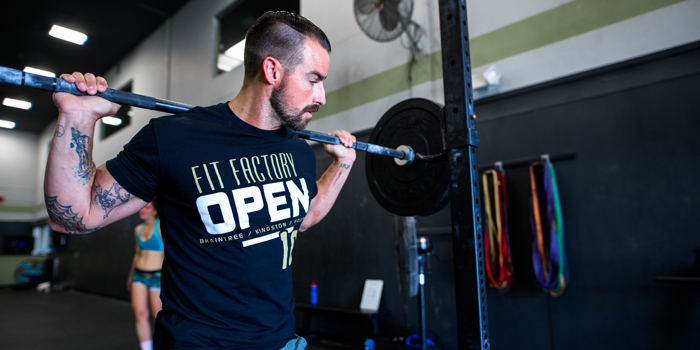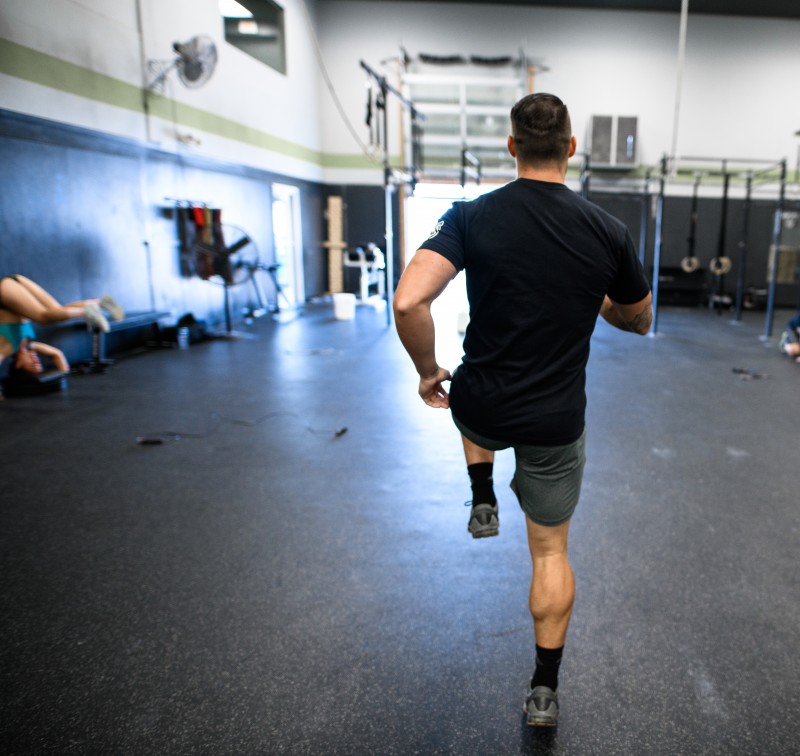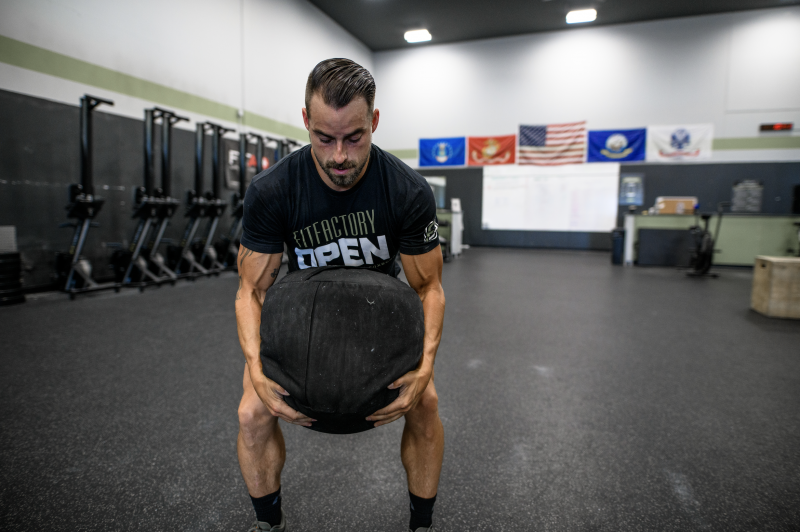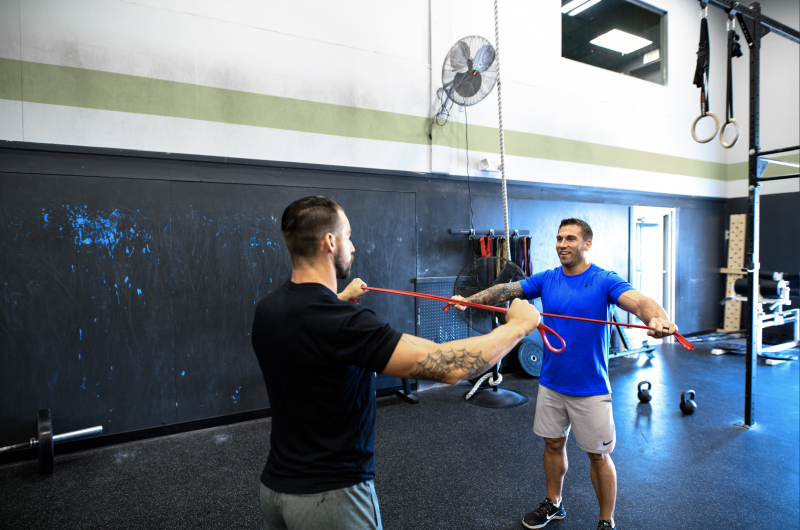
The average competitor these days has impressive stats. Being able to run a sub-six-minute mile and deadlift 500 pounds isn't a huge deal anymore.
In the strength and conditioning world, you would seldom hear of athletes that possess both explosive and enduring qualities.
When I was an intern at a strength and conditioning facility in my area back in the early 2000s, I remember one of the coaches talking about a friend of his that ran marathons. This same friend could also squat close to 500 pounds, ass to grass.
RECENT: How to Increase Work Capacity Without Overtraining
I can vividly remember hearing this coach say that his friend was an anomaly and that very few athletes have both absolute strength and great endurance in one package.
Of course, I didn't give it much thought until some years later when I first tried box programming.
This opened up the door to understanding how to train multiple qualities simultaneously. I'm sure many coaches are going to read this and think that the notion is still heresy, but the fact of the matter is that athletes all over the world are training with these goals in mind and making great progress.
This article certainly isn't intended to give justification that a concurrent model of programming will work; more so, it is to shed light on how this model can be improved. Whether you're coaching general population athletes or a Games athlete, these tenets of programming cannot be ignored.
Recovery
One of the biggest things that irritate me about the fitness industry is the mindset of burying your clients on a daily basis in an effort to get them closer to their goals. This application of thinking is incredibly flawed, and in a world where people are already chronically stressed out, it's surprising that recovery is an aspect of programming that typically isn't given much thought.
Although one of the solutions to this issue may be as simple as listening to your body and taking more rest days, many athletes fail to listen to the signs their bodies are giving them. At a certain point, these athletes will incur diminishing returns with their training gains. And of course, many will invariably overtrain if they're not taking planned and unplanned rest days.

A February 2019 study by O'Neil et al., tested physical activity in rodents, of which I was made aware via Joel Jamieson. Their findings were pretty interesting:
"Exercise is a common component of weight loss strategies, yet exercise programs are associated with surprisingly small changes in body weight [1-4]. This may be due in part to compensatory adaptations, in which calories expended during exercise are counteracted by decreases in other aspects of energy expenditure [1, 5-10]. Here we examined the relationship between a rodent model of voluntary exercise- wheel running- and total daily energy expenditure.
"Use of a running wheel for 3 to 7 days increased daily energy expenditure, resulting in a caloric deficit of ∼1 kcal/day; however, total daily energy expenditure remained stable after the first week of wheel access, despite further increases in wheel use. We hypothesized that compensatory mechanisms accounted for the lack of increase in daily energy expenditure after the first week.
"Supporting this idea, we observed a decrease in off-wheel ambulation when mice were using the wheels, indicating behavioral compensation. Finally, we asked whether individual variation in wheel use within a group of mice would be associated with different levels of daily energy expenditure.
"Despite a large variation in wheel running, we did not observe a significant relationship between the amount of daily wheel running and total daily energy expenditure or energy intake across mice.
"Together, our experiments support a model in which the transition from sedentary to light activity is associated with an increase in daily energy expenditure, but further increases in physical activity produce diminishingly small increments in daily energy expenditure."
To sum it up, merely adding more exercise beyond a certain point will not yield the results that most think. Additionally, compounding stress with stress will likely cause exhaustion (remember GAS, which you learned in your intro to exercise phys ed class?).
In the box world, seminar staff coaches preach intensity with the premise that “all intensity is relative.” That notion that has some validity as we all face different stressors in our daily lives, but putting intensity at the top of the training hierarchy has inherent risks. Let me explain: the added level of competition, fear, and judgment creates an entirely unforeseen level of stress to an already stressful high-threshold workout or even a low-threshold conditioning piece for the competitor.
I'd venture to say that many of these same coaches might not be taking into consideration the physiological changes that take place because of these aspects alone. As a result, burnout amongst competitors that adhere to programs that prescribe high-intensity work regularly will likely end negatively.
The Solution: Smarter Conditioning
“Go hard AF” is a one-way ticket to overtraining and the methodology that too many subscribe to. Don’t be fooled by social media as simply adding more intensity/training sessions does not equal more results; it’s likely if you’ve been around the block a few times, you’ve experienced this.
What is a better approach is actually knowing the difference between the aerobic and anaerobic systems, how the two overlap in just about every single metcon, and how we can improve the two most effectively.
The funny part is that box programming is far more aerobic than it is anaerobic, yet the premise of the system is based on “high-intensity.” What I mentioned before about box seminar coaches stating that “intensity is relative” can be said about just about anything, but what’s better is actually knowing what the desired outcome and the why of every single metcon in your plan.
The best possible option is to focus on building the base of fitness, which is the aerobic system. The aerobic system affords us the ability to recover better and live longer — its connections between endurance and lifespan are pretty well established via multiple studies. Without an efficient aerobic system, you will never be that great at box training, either.
On a weekly basis, some use some variant of:
- The cardiac output method should be done at least once a week in our plan. This is cyclical style work (i.e. light row, jog, run, light sled pull for 30+ minutes with a heart rate of 130-150 BPM — conversational). This will carry over like you wouldn’t believe to other modalities.
- Work to rest conditioning pieces. If you’re not using planned rest in at least 1-2 workouts a week, then you’re setting yourself up to never improve your work output.
- Understand the connection between the amount of muscle worked with a given movement and how that relates to spiking the heart rate. Globally demanding movements like snatches, burpees, and thrusters should be used strategically and not randomly.
Benefits of improving the aerobic system:
- Improved sleep = improved recovery
- Improved ability to pump blood to the extremities = increase the ability to do more work
- Improved ability to replenish ATP for explosive movements — think about going from an endurance event to a 1RM event more efficiently
- Decreased resting heart rate = ability to do more work aerobically
Prioritize Assistance Work
Just like how box programming has made big compound movements attractive to the general population, the box movement has also made single-limb work less popular, deeming it to be "non-functional." One of the biggest missing links in most programming for athletes of all levels is the lack of attention to improving imbalance. For competitors, accessory work is often an afterthought, as they have “bigger fish to fry.” This is a huge mistake.
Quite frankly, this work is just as important as work with compound movements and the Olympic lifts. Too often we see many athletes trying to improve their big lifts by simply doing the lifts, and for some, this will work, but for how long is another story.
Chances are their lifts have stalled because they haven't made any attempts to improve the primary movers that assist the movement, and by merely performing the movement more, they'll more than likely regress or incur an overuse injury.
Adding assistance work can help you address your limiting factors whereas compensation patterns may only be exacerbated with a bilateral movement. Because the demand for these movements is low, it's much safer to add high amounts of volume.
As Louie Simmons says, "You're only as strong as your weakest link." Spend the bulk of your time using special exercises to improve your lagging muscle groups, and your bilateral movements will be rewarded. Not to mention these athletes will improve body composition at the same time.
Although the inclusion of single-joint work is much less involved than the inclusion of aerobic work, this work needs to be prioritized on a weekly basis. I'm not talking about an entire session of single-joint work; more like two to three exercises after your strength session or at the end of your conditioning session.
Additionally, one strategy that I've stolen from Louie Simmons is the inclusion of high-volume band work. This work is easily added at the end of your training session and provides a huge return on investment. In the description, high volume band work can effectively improve soft-tissue, as well as increasing the amount of stored kinetic energy available (Simmons, 2015).
Here are a few examples:
After an intensive hip-dominant lower-body session:
- Reverse Hypers™: 4 x 25 @50% of back squat 1RM. Rest 60 seconds.
- Standing Banded Ab Pulldowns: 4 x 25. Rest 60 seconds.
After an intensive knee-dominant lower-body session:
- Glute Ham Raises: 5 x 8-10. Rest 60 seconds.
- Backward Sled Pull Backpedal holding a medicine ball: 6 x 40 yards. Rest 60 seconds.
After an intensive upper-body session:
- Overhead Banded Triceps Extensions: 3 x 50. No rest.
- Banded Facepull-aparts: 3 x 50. No rest.
Absolute Strength Work
It's become quite clear to me as a coach that many high-level box athletes lack absolute strength. If you've ever heard the podcast the Louie Simmons did with Barbell Shrugged back in 2013, he was asked the question: what are box athletes lacking?
His answer was "absolute strength." Simply defined, absolute strength is the greatest amount of force that can be voluntarily produced regardless of time. (Verkhoshansky, 2003). To put this into context, many competitive box athletes lack strength in all lifts, and as a result, put huge amounts of emphasis on technique with the Olympic lifts.
In addition, many coaches neglect using the max effort method and opt for higher repetition work with compound movements. As a result, their progress is limited and largely determined by how strong they are with a true 1RM.
By using the max effort method, our aim is to increase 1RM in a new variation each week. This builds great amounts of absolute strength that will be applicable to other aspects of an athlete's performance.
We've seen huge correlations with increases in the Olympic lifts by simply increasing strength with the squat and deadlift. In these cases, minimal technique work is done with our programming, yet our athletes always hit new personal records when we test their Olympic lifts.
A few things to keep in mind when using the max effort method:
- Volume is intended to be low, three singles above 90 percent.
- Max effort variations must be rotated weekly. This will ensure we avoid accommodation and overuse injury.
- Because variations are often rotated, athletes will be able to address individual limitations with a given movement.
- Max effort work must be separated from dynamic effort work or high-threshold conditioning work by at least 72 hours
I'm a huge fan of using variations that force athletes to develop force from disadvantageous positions. Variations like rack pulls, Anderson Squats, box squats, and pressing off of pins fit the bill.

Included in the development of absolute strength are sled pulling and loaded carries. For strength and conditioning, these are two aspects of programming that will likely be prioritized on the regular. On the contrary, box coaches may simply forget to include such work in the midst of an overload of training modalities.
These two aspects of programming are crucial to the development of your athletes' bases. Moreover, both sled pulls and loaded carry variations can provide high-resistance aerobic training, and effectively improve the aerobic abilities of the fast-twitch fibers, which means high power can be maintained longer (Jamieson, 2009).
Prioritize Cooldowns After Every Session
In the strength and conditioning world, cooldowns have been around for as long as I can remember, and it makes sense when we are thinking about optimizing both spectrums of the central nervous system.
But in a box, leaving the gym with a heart rate of 180 BPM is commonplace. This is one of the bigger changes we’ve made to our programming—including measures that anyone can do after class to drive recovery via the parasympathetic nervous system.
Oftentimes, box competitors want to do more, and no one is taking away from their work ethic and dedication to their craft, but really they’d be better served to focus on improving their recovery not to mention their sleep patterns — we can certainly control the implementation of easy recovery measures.
Now that we’ve concluded our training session, it’s the perfect time to use foam rolling to enhance lymphatic drainage. This foam rolling is done globally on large/dense musculature with six to twelve inches of relative motion.
Next, using full-body static stretching is another mechanism to drive rest and recovery via the parasympathetic nervous system.
Do positional parasympathetic breathing drills for roughly three minutes, and then add the last and arguably most vital aspect of our cooldown.
Here’s your cooldown protocol:
- Global Foam Rolling: 6-12 inches of relative motion rolling proximal to distal. This is done on the same musculature you foam roll in your warm-up, but now the execution is different to expedite recovery.
- Static Stretching: Same as done in your warm-up.
- Parasympathetic Breathing Drills: 15-20 Breaths with a 3 second inhale + 1-second hold + 3 seconds exhale +1 second hold at the bottom
The cooldown allows us to build the athletes' recovery up as much as our training is strategically breaking them down. And a more recovered athlete means a healthier client in both the short-term and long-term in a day and age where chronic burnouts and injuries have become the norm.
In short, it's important to remember that only working harder or punishing your athletes will not necessarily mean they're going to incur improvements with their fitness. This is critically important for the competitive athlete who is pushing the boundaries, both mentally and physically.
If you only take one thing away from this article, it should be that recovery is actually as essential as the training itself. Much like how we carefully plan our programming, our recovery should be given the same level of attention.
A few summers ago, I was talking with Dave Tate, and it was a conversation I’ll never forget. I often think back to the point in our conversation in which I said, "I've found in most cases, that less is usually more with programming."
Dave said, "No, that's always the case."
I think it's safe to say that working smarter instead of harder can apply to both the competitive athlete as well as the individual training for general fitness.
Image credit: RX Photography











